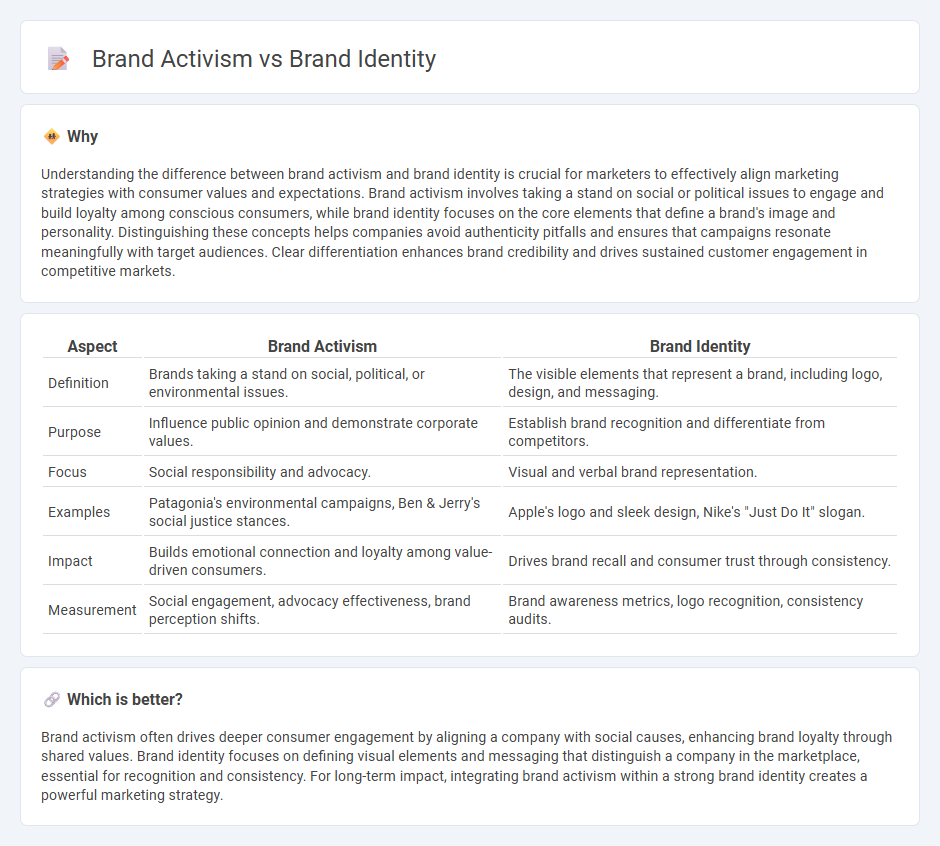
Brand activism represents a company's commitment to social, environmental, or political causes, aiming to foster positive change and resonate with values-driven consumers. Brand identity focuses on the visual, emotional, and cultural elements that define how a brand is perceived, including logos, messaging, and overall personality. Explore the key differences and strategic benefits of brand activism and brand identity to enhance your marketing efforts.
Why it is important
Understanding the difference between brand activism and brand identity is crucial for marketers to effectively align marketing strategies with consumer values and expectations. Brand activism involves taking a stand on social or political issues to engage and build loyalty among conscious consumers, while brand identity focuses on the core elements that define a brand's image and personality. Distinguishing these concepts helps companies avoid authenticity pitfalls and ensures that campaigns resonate meaningfully with target audiences. Clear differentiation enhances brand credibility and drives sustained customer engagement in competitive markets.
Comparison Table
| Aspect | Brand Activism | Brand Identity |
|---|---|---|
| Definition | Brands taking a stand on social, political, or environmental issues. | The visible elements that represent a brand, including logo, design, and messaging. |
| Purpose | Influence public opinion and demonstrate corporate values. | Establish brand recognition and differentiate from competitors. |
| Focus | Social responsibility and advocacy. | Visual and verbal brand representation. |
| Examples | Patagonia's environmental campaigns, Ben & Jerry's social justice stances. | Apple's logo and sleek design, Nike's "Just Do It" slogan. |
| Impact | Builds emotional connection and loyalty among value-driven consumers. | Drives brand recall and consumer trust through consistency. |
| Measurement | Social engagement, advocacy effectiveness, brand perception shifts. | Brand awareness metrics, logo recognition, consistency audits. |
Which is better?
Brand activism often drives deeper consumer engagement by aligning a company with social causes, enhancing brand loyalty through shared values. Brand identity focuses on defining visual elements and messaging that distinguish a company in the marketplace, essential for recognition and consistency. For long-term impact, integrating brand activism within a strong brand identity creates a powerful marketing strategy.
Connection
Brand activism strengthens brand identity by aligning a company's values with social or environmental causes that resonate with target audiences. This alignment enhances customer loyalty and differentiates the brand in competitive markets through authentic, purpose-driven messaging. Consumers increasingly seek brands that demonstrate commitment beyond profits, making activism a critical component of a compelling brand identity.
Key Terms
Brand Identity:
Brand identity encompasses the visual elements, messaging, and overall persona that define a company's unique image in the marketplace, including logos, color schemes, typography, and tone of voice. It establishes brand recognition and fosters customer loyalty by consistently conveying the brand's core values and mission. Explore how strong brand identity drives business success and distinguishes brands in competitive markets.
Logo
Brand identity centers on the logo as a visual representation of a company's values, personality, and market position, creating immediate recognition and fostering trust among consumers. Brand activism, on the other hand, uses the logo as a symbol of a company's commitment to social, political, or environmental causes, enhancing emotional connections and aligning with consumer values. Explore how your logo can balance visual appeal with meaningful messaging to strengthen both brand identity and activism.
Brand Voice
Brand identity defines a company's core values, visual style, and consistent messaging, establishing a unique Brand Voice that resonates with its target audience. Brand activism uses this Brand Voice to champion social, environmental, or political causes, reinforcing authenticity and fostering deeper engagement. Explore how aligning Brand Voice with activism can amplify impact and customer loyalty.
Source and External Links
What Is Brand Identity? | The Branding Journal - Brand identity is the unique set of characteristics that personify a brand, influencing how it wants to be perceived, differentiating it from competitors, and building emotional connections and consistency for long-term success.
What Is Brand Identity? 6 Key Elements - Shopify - Brand identity consists of specific design and messaging elements such as logo, color scheme, typography, voice, and tone that together make a company distinct and recognizable.
What is brand identity? (and how to build one) - Canva - Brand identity is the combination of visual and content choices, including colors, fonts, voice, and tone, that represent a company's personality and communicate its mission and values to its audience.
 dowidth.com
dowidth.com